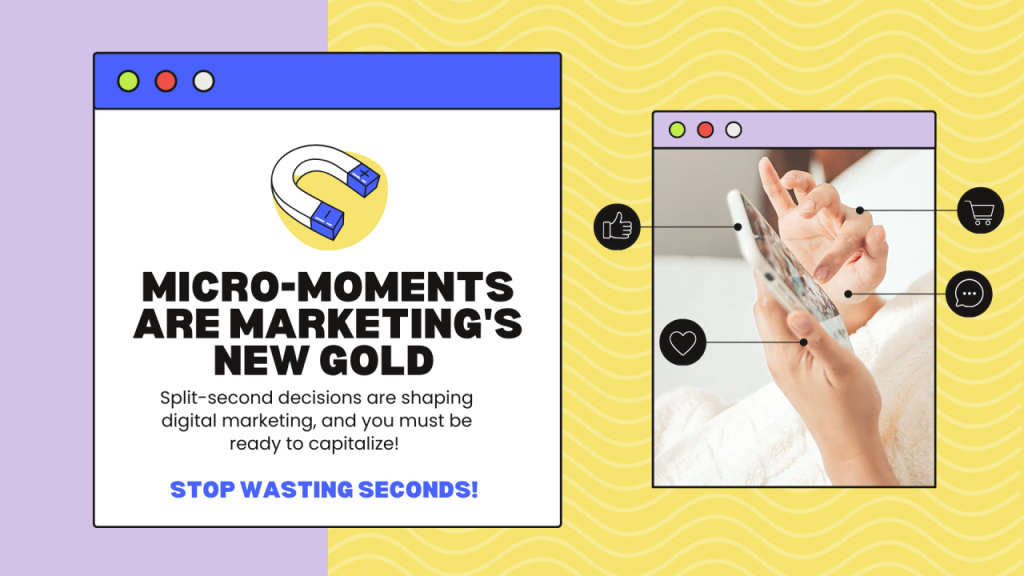
In today’s digital-first world, consumer behavior has become increasingly fragmented. People don’t always follow a traditional path to purchase anymore. Instead, they act on specific needs in real time—searching for information, making decisions, and buying products within seconds. These intent-rich touchpoints are called micro-moments, and they have become one of the most critical opportunities for brands to engage their audience in a meaningful and timely manner.
Understanding Micro-Moments –
A micro-moment is a brief, high-intent instance when a person turns to their device—typically a smartphone—to act on a need: to learn something, go somewhere, do something, or buy something. These moments are not planned. They happen spontaneously, driven by curiosity, urgency, or convenience. For example, when someone searches for “best travel backpacks for hiking” while at an airport or looks up “quick pasta recipes” before dinner, they are in a micro-moment. What makes these moments powerful is the user’s intent. They’re actively seeking answers, and if your brand is present with the right content, you have a unique opportunity to guide their decision-making.
Types of Micro-Moments –
Google categorizes micro-moments into four types: “I-want-to-know,” “I-want-to-go,” “I-want-to-do,” and “I-want-to-buy.” Each type represents a different stage of consumer intent. The “I-want-to-know” moment involves someone researching or exploring without the intent to purchase—like comparing two smartphone models. The “I-want-to-go” moment occurs when someone is searching for a nearby business, such as “vegan restaurants near me.” The “I-want-to-do” moment is action-oriented, like watching a tutorial on how to apply eyeliner. Finally, the “I-want-to-buy” moment signifies purchase intent, often with users comparing prices, reading reviews, or finding the fastest way to buy a product. Each of these moments represents an opportunity for marketers to be helpful and persuasive.
Why Micro-Moments Matter in Digital Marketing –
The value of micro-moments lies in their immediacy and intent. Studies show that more than 90% of mobile users are not committed to a specific brand when they start searching online. That means brands that show up with relevant, timely, and helpful information can influence choices and convert users instantly. These fleeting moments have become the new battleground for customer attention. In a world where users expect instant answers and seamless digital experiences, being visible at the right time can make the difference between winning or losing a customer.
Strategies to Leverage Micro-Moments –
To effectively capitalize on micro-moments, brands must adopt a strategy built on presence, relevance, and speed. First, you need to be there. This means ensuring your brand appears when users are searching, whether through paid search, local SEO, or mobile optimization. Understanding your audience’s search behavior helps you create content that addresses their real-time needs.
Next, be useful. Simply appearing in search results isn’t enough. You must deliver valuable content that answers questions or solves problems. Whether it’s a product guide, a location map, or a tutorial video, your content must match the user’s intent and expectations.
Lastly, be quick. Micro-moments happen in seconds, and users have little patience for slow websites or complicated navigation. Ensure your site loads fast, especially on mobile devices, and streamline the user journey—whether it’s browsing, learning, or checking out. Reducing friction during these moments leads to higher conversions and a better overall experience.
Real-World Applications –
Several brands have successfully adapted their marketing strategies to embrace micro-moments. Starbucks, for instance, uses location-based targeting to capture “I-want-to-go” moments, allowing users to find nearby stores and order ahead. IKEA addresses “I-want-to-buy” moments with augmented reality, letting users visualize how furniture fits in their space before making a purchase. Meanwhile, beauty brands like Sephora respond to “I-want-to-do” moments by offering tutorials and virtual try-on tools. These examples show how aligning marketing efforts with user intent at the right time can drive engagement and build stronger customer relationships.
Conclusion –
Micro-moments have transformed how consumers make decisions—and how brands must respond. These short bursts of decision-making are full of intent and demand instant, relevant responses. In a landscape where attention is fleeting and loyalty is earned one moment at a time, being present and helpful in micro-moments is no longer optional—it’s essential. Brands that can anticipate needs, respond with speed, and deliver value will be the ones that capture not just clicks, but lasting customer trust. By understanding and integrating micro-moments into your digital marketing strategy, you position your brand to win the moments that truly matter.

